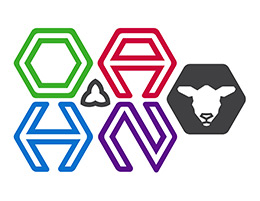Small Ruminant Veterinary Report – Dec 2024 – Apr 2025
Ontario Animal Health Network (OAHN)
Small Ruminant Expert Network
Report
Animal Health Laboratory Q4 2024 & Q1 2025 Case Summary Data
Prepared by Dr. Amanda Mansz, AHL Pathologist
Q4 2024 & Q1 2025 Small Ruminant Case Submission totals
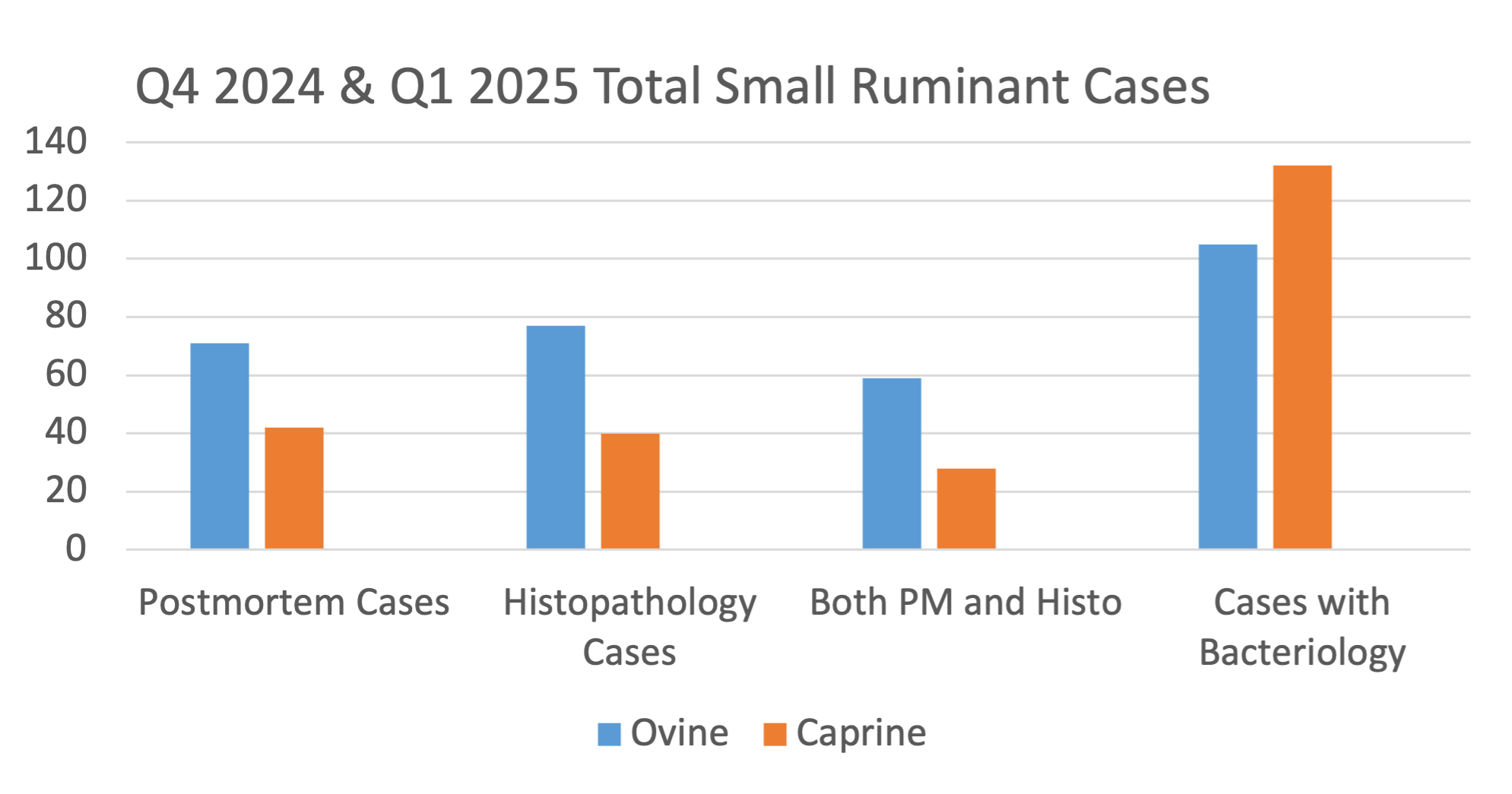
- 21 and 52 ovine postmortem cases were submitted to the AHL and OVC-PBI during 2024 Q4 and 2025 Q1. A total of 26 and 52 histopathology cases from both laboratory and on-farm postmortems/biopsy were also examined by pathologists. A total of 17 and 42 cases had both postmortem and histology performed; this comprised 81 and 81 % of total postmortems submitted.
- A total of 14 and 28 caprine postmortem cases were submitted to the AHL and OVC-PBI during 2024 Q2 and 3. A total of 11 and 29 histopathology cases from both laboratory and on-farm postmortems/biopsy were also examined by pathologists. A total of 10 and 18 cases had both postmortem and histology performed; this comprised 71 and 64 % of total postmortems submitted.
Abortion case findings for ovine (left) and caprine (right)
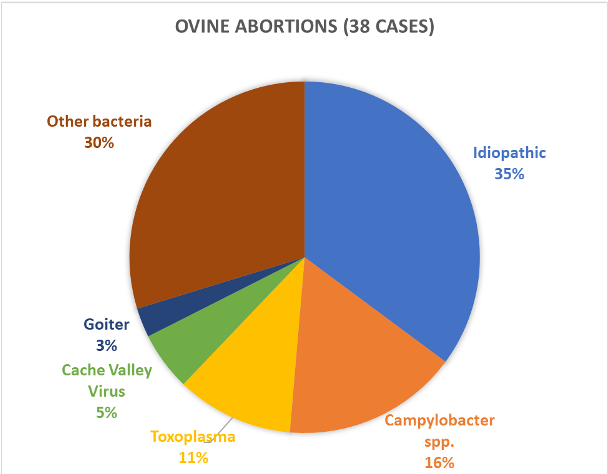

Ovine comments: The numbers of ovine abortion cases (38) submitted follows a similar spring increase in submissions seen every year.
13 Idiopathic abortions: 6 did not receive a full work (postmortem, histopathology, bacteriology, Coxiella/chlamydia/toxoplasma PCR), 7 had a full workup and were suspected to be non-infectious cause. 6 were attributed to Campylobacter spp (5 Campylobacter jejuni, 1 Campylobacter fetus). 11 of the “other bacteria” are attributed to Salmonella spp., all from a single premises.
Caprine comments: The numbers of caprine abortion cases (10) submitted this Q4, Q1 is similar to previous quarter submissions. 6 Idiopathic abortions: 2 had full workups with no microscopic inflammatory lesions suggesting non-infectious causes, the remainder of the cases did not receive a full work up.
Respiratory case findings for ovine and caprine workups
This is a representation of the pathogens identified from samples submitted in Q4 2024 and Q1 2025. The pathogens listed are not necessarily the primary pathogen causing pneumonia or the cause of death/disease and should not be interpreted as such.
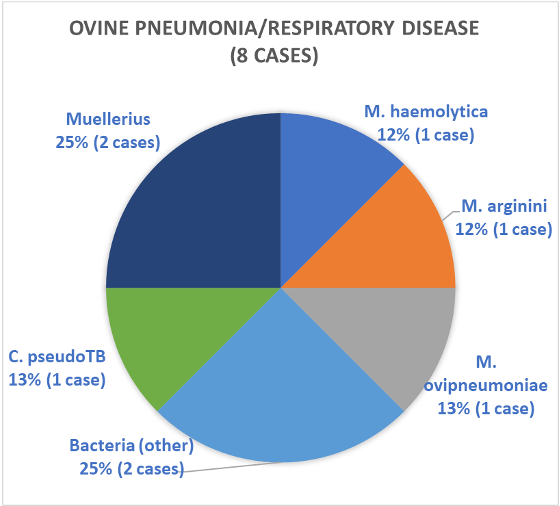
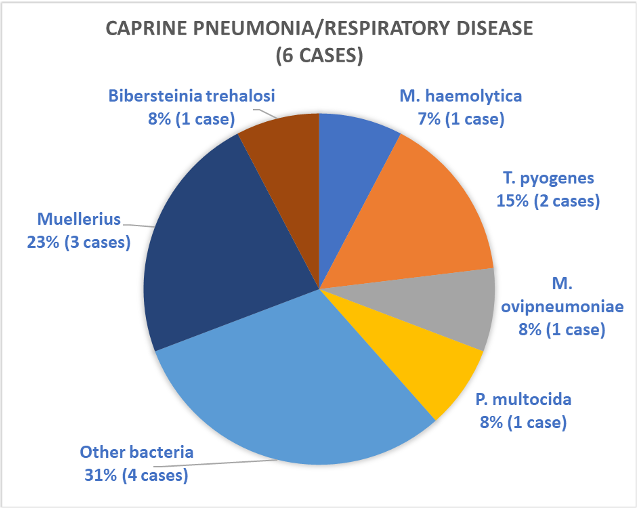
Ovine comments: Case numbers are slightly lower than previous quarters. No cases of MVV or Nasal adenocarcinoma were diagnosed by pathologists.
Caprine comments: “Other bacteria” include cases with histological lesions of bacterial pneumonia without culture. No cases of CAE were diagnosed by pathologists.
| Sheep | Goat | |
| CNS | Four cases: 1 case of Listeria and 3 Idopathic cases: 1 suspect Toxoplasmosis (no ancillary testing), 1 salt toxicosis/water deprivation and 1 trauma.
|
Five cases: Causes are largely equal between Listeriosis, Idiopathic (is presumed to be due to aberrant parasite migration (P. tenuis or Baylisascaris procyonis), Polio, T. pyogenes, and bacteria not identified due to a lack of culture. |
| GI Parasitology | Case numbers for these last 2 quarters together were slightly increased from the previous quarters: 19 cases (31 samples). As usual, the most frequently identified parasites were coccidia 20 (31) and GIN eggs 8 (18). There were 6 (6) diagnoses of cestodes (tapeworms), 3 (4) of Nematodirus (roundworms), 8 (10) Strongyloides (threads) and 6 (8) Trichuris (whips). NO cases of haemonchus were diagnosed by pathologists.
|
Submissions were on par with previous quarters (total for both quarters is 28 cases (47 samples), and the most frequently identified parasites by flock including coccidia (22 cases), GINs (12), Trichuris (whips) (6), and Cryptosporidia (6). There were 0 cases of cestode/Moniezia (tapeworm) and 5 of Strongyloides (threads), 3 Muellerius (lung worm), 1 Nematodirus (roundworms) and 3 of Skrjabinema caprae (pinworm). No case of haemonchosis were diagnosed by pathologists.
|
| Enteritis (includes ETEC, EPEC, Rotavirus, other bacteria, rumenitis, bloat and idiopathic) | 1 case of rumenitis, 3 cases of lambs with Rota B (same premises), 1 idiopathic, 1 case of intestinal adenocarcinoma in an adult was included (although not really “enteritis”).
|
No cases. |
| Clostridium perferingens | Isolation was similar to previous quarters. in total 81 cases isolated Clostridium perfringens and only 3 were genotyped. Only 2 was typed as C. perfringens type D causing enterotoxemia (1 C. perfringens type A with Beta-2 toxin). No cases of Enterotoxemia were diagnosed based on pathology alone.
|
Isolation was increased compared to previous quarters. Nineteen cases isolated Clostridium perfringens and 9 were genotyped. Six were typed as C. perfringens type D causing enterotoxemia (1 C. perfringens type A, 2 C. perfringens type A with Beta-2 toxin). No cases of Enterotoxemia were diagnosed based on pathology alone |
| Salmonella | 30 cases (212 samples) of bacterial culture received Salmonella enrichment (large increase – attributed to the single premises outbreak) and there were 19 positive Salmonella detections.. Many of these cases (S. agona) resulted in abortion with sick ewes with enterocolitis.
|
22 cases of bacterial culture received Salmonella enrichment, and there were no detections.
|
| Johne’s Disease | Johne’s submissions are similar in number to the past quarters. In Q4 6 cases (58 samples) and in Q1 54 cases (84 samples) were submitted for ELISA and in Q4 12 cases (13 samples) and Q1 15 cases (26 samples) for PCR. In both quarters there were no positive cases.
|
Johne’s submissions continued at the same rate as previous quarters. A total of 107 cases (435 samples) were tested in Q4 and Q1 combined; 24 (96) ELISAs and 33(35) PCRs in Q4 and 20 (222) ELISAs and 30 (100) PCRs in Q1 PCRs. In both quarters 14 cases (87 samples) were positive by ELISA and 9 (18 samples) were positive by PCR. An additional one case was diagnosed by a pathologist.
|
| Maedi-Visna Virus/Caprine arthritis encephalitis | The numbers of serologic tests performed for Maedi-Visna virus is slightly decreased from the previous quarters with a case number of 30 (489 individual serum samples) and 27 (368) in Q4 and Q1. The positive case rate (one or more positive samples per case submission) was 30 % (9 total positive cases) and 44 % (12 total positive cases) – previous quarters 36 % (2024 Q3). | The numbers of serologic tests performed for CAE virus has slightly increased from previous quarters with a case number of 43 (1209 serum samples) in Q4 and 41 (1473 serum samples) in Q1. There were 38 positive cases (423 samples) which is on trend with previous quarters. No cases were diagnosed by pathologists.
|
| Copper Toxicity | No ovine or caprine cases.
|
|
| Scrapie | There were 10 cases (12 samples) submitted for testing; NO positive cases.
|
There were 1 case (2 samples) submitted for testing; NO positive. |
Mastitis Pathogens from Milk Cultures Submitted to the Animal Health Laboratory in 2023 and 2024
Summary provided by Dr. Tanya Rossi
In 2024, there were 34 submissions, 137 individual milk samples, sent to the AHL resulting in 103 results.

** CNS: Staphylococcus caprae, epidermidis, and simulans.
Provincial Abattoir Slaughter and Condemnation Data
Prepared by Drs. Hannah Golightly and Bukunmi Odebunmi
Provincial slaughter data for goat, sheep, and lamb, Jan 2023 to May 2025.
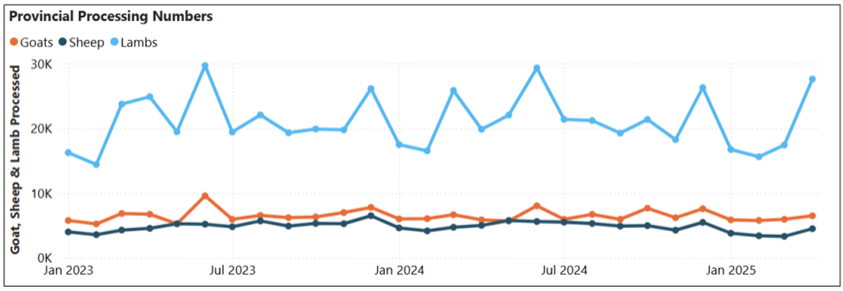
Top 5 condemnation reasons for goat, sheep, and lamb at provincial abattoirs, April 2024-2025

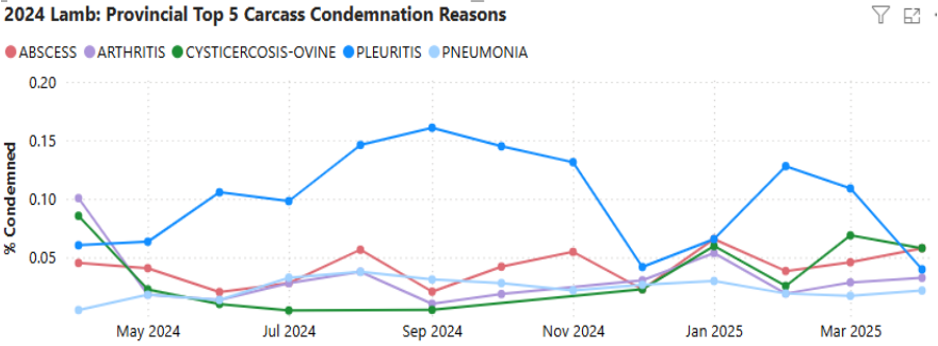
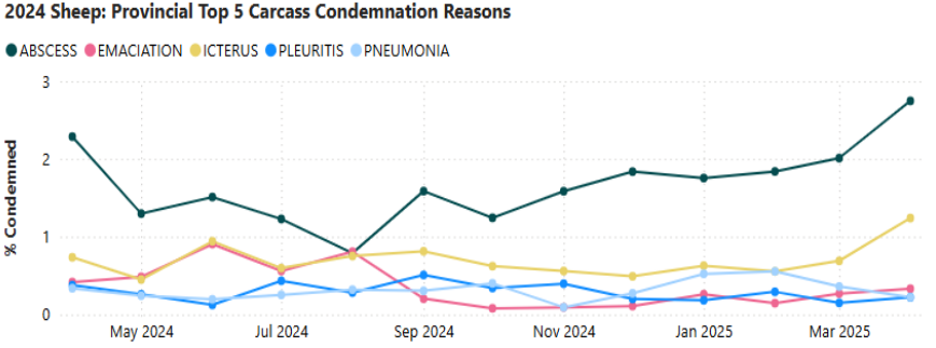
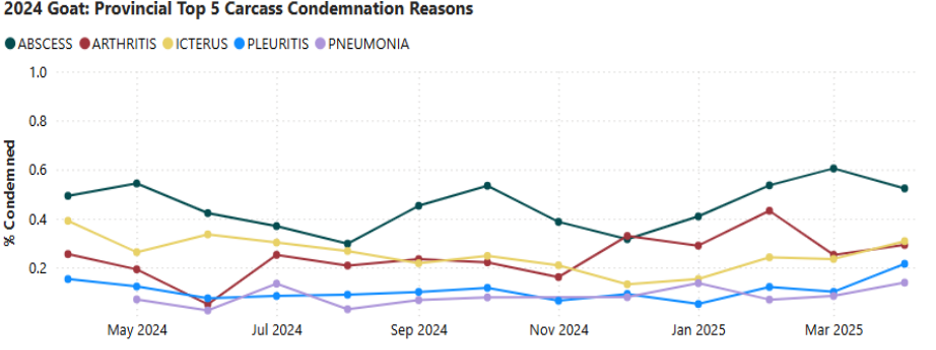
International Disease Topics of Concern
FMD
Foot and mouth disease made an unexpected appearance in 2 European countries in 2025. On January 13, Germany reported a detection in 3 water buffaloes and applied stamping out measures. As of April 14, WOAH has reinstated Germany’s “FMD-free country where vaccination is not practiced” status. On March 7, Hungary reported a detection in dairy heifers located in close proximity to the Hungary-Slovakia border. On March 21, Slovakia reported confirmed FMD in cattle farms near the Hungary border. A total of 5 farms in Hungary and 6 farms in Slovakia were found to be positive with the last detection on April 17, 2025. Vaccination and zoning have been applied and control measures and monitoring continue at this time. The source is currently unknown. For updates: Foot-and-mouth disease – European Commission
New World ScrewWorm
The New World screwworm (NWS) is currently experiencing a resurgence in Central America and Mexico. While eradicated from the United States in the 1960s, and from Central America by the early 2000s, recent detections in Mexico have prompted the temporary suspension of live animal imports through certain U.S. border ports. In response to the outbreak, the USDA has partnered with Mexico and other affected countries to combat the spread of NWS. This collaboration includes the use of sterile insect technique (SIT), which involves releasing sterilized flies to reduce the screwworm population. New World Screwworm What You need to Know
